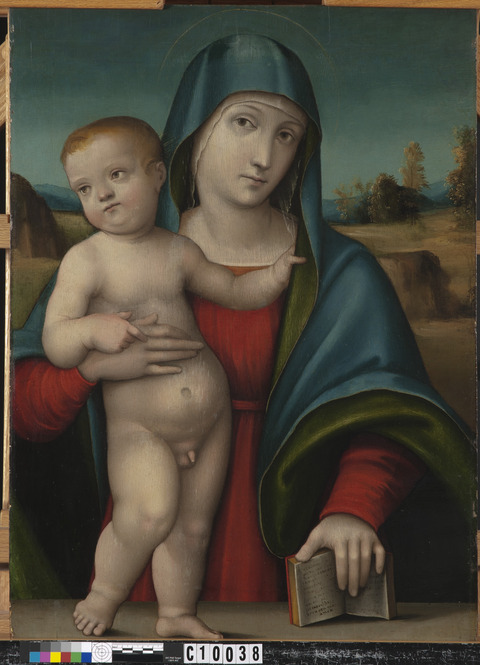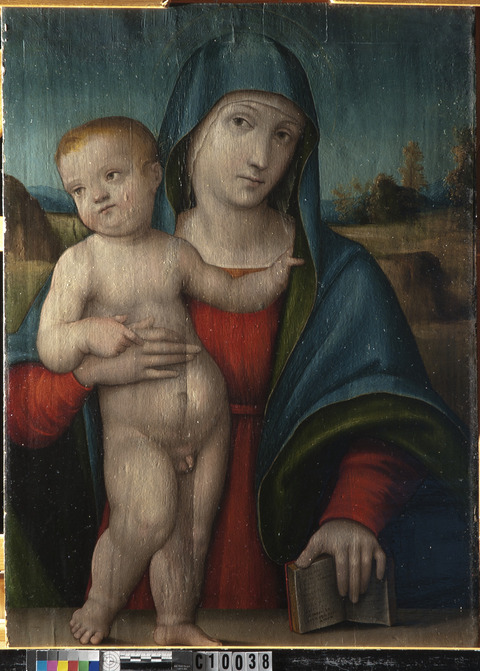Overview
Accession number: 2017.90
Artist: Giulio Francia
Title: Madonna and Child
Materials: Oil (untested) on poplar panel
Date of creation: About 1515
Previous number/accession number: C10038
Dimensions: 63.1 × 46.3 cm
Conservator/examiner: Fiona Beckett with contributions from Roxane Sperber and Gregory D. Smith
Examination completed: 2014, revised 2020
Distinguishing Marks
Front:
None
Back:
None
Summary of Treatment History
Physical evidence suggests the painting was subject to numerous aesthetic and structural interventions before 1971, when the work entered the Indianapolis Museum of Art (IMA) collection on long-term loan. The painting was cradled and additions were made to the top of the panel before or at the time the work was cradled. Elemental analysis of the paint layer on the additions suggests they were added in the nineteenth century after chrome yellow and zinc white pigments were introduced as artists' colors. Evidence of past varnish removal and retouching are visible.
Documentation suggests a series of condition assessments and treatments were carried out on the collection at about the time the works were moved from the Clowes residence to the IMA collection in 1971. A condition report by Paul Spheeris in October of that year, likely carried out before the paintings were relocated, described the painting as having a damaged frame. He commented that no treatment was necessary.1 A second condition assessment was carried out upon arrival of the paintings at the IMA. This assessment describes the work as in good condition and no treatment was deemed necessary.2
In 1974, a condition assessment, treatment, and investigation of the collection was carried out by the Intermuseum Conservation Association at Oberlin College. This document describes this painting in its current construction with a natural resin varnish that had slightly discolored and that was very glossy. However, no treatment was recommended.3
In 1996, a memorandum summarizing treatment and examination of the Clowes Collection from the time it entered the collection suggests that a minor treatment was undertaking in 1981 to set down cleavage and remove bloom and add a surface coating. In 1990 a minor inpainting of a loss in the varnish layer was undertaken.4 Wood identification was carried out by Peter Klein in February 1999, and the panel was found to be poplar (Populus spp.).5
The painting was examined and documented in the Clowes Collection annual survey from 2011 to 2020.
Current Condition Summary
Aesthetically, the painting is in poor condition due to significant areas of discolored retouching. This is particularly disfiguring in the skin tones of the Christ figure as they obscure the natural cracking network of the underlying paint layer. Structurally the painting is sound, with previous structural treatments intact.
Methods of Examination, Imaging, and Analysis
| Examination/Imaging | Analysis (no sample required) | Analysis (sample required) |
|---|---|---|
| Unaided eye | Dendrochronology | Microchemical analysis |
| Optical microscopy | Wood identification | Fiber ID |
| Incident light | Microchemical analysis | Cross-section sampling |
| Raking light | Thread count analysis | Dispersed pigment sample |
| Reflected/specular light | X-ray fluorescence spectroscopy (XRF) | Fourier-transform infrared spectroscopy (FTIR) |
| Transmitted light | Macro X-ray fluorescence scanning (MA-XRF) | Raman microspectroscopy |
| Ultraviolet-induced visible fluorescence (UV) | ||
| Infrared reflectography (IRR) | Gas chromatography–mass spectrometry (GC-MS) | |
| Infrared transmittography (IRT) | Scanning electron microscope -energy dispersive X-ray spectroscopy (SEM-EDS) | |
| Infrared luminescence | Other: | |
| X-radiography |
Technical Examination
Description of Support
Analyzed Observed
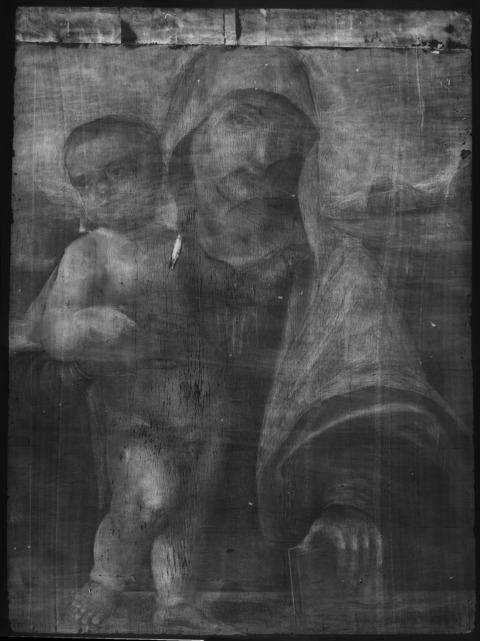
Material (fabric, wood, metal, dendrochronology results, fiber ID information, etc.):
The painting support is wood panel with vertically oriented grain (tech. fig. 1).6 According to wood identification by Peter Klein, both the panel and the cradle are poplar (Populus spp.). Examination of the bottom edge of the original panel suggests the board was tangentially sawn.
Characteristics of Construction / Fabrication (cusping, beveled edges of panels, seams, joins, battens):
The main portion of the panel is constructed from a single piece of wood. An addition was secured to the top, extending the length of the panel by 4 cm. The addition is unusual as it was constructed from five pieces of wood of varying cuts, likely scraps from other panels. These sections were glued to each other and then to the main panel (tech. figs. 2, 3). These additions were likely applied in the nineteenth century based on the pigments present in this area (see paint analysis). One possible explanation for the addition is that the top was trimmed to remove a particularly damaged area. The panel is approximately 0.6 cm thick, with relatively even thickness throughout. The cradle members cleverly cover the joins of these additions on the back; however, they remain visible on the front because of cracks in the paint layer.


Thickness (for panels or boards):
Approximately 0.6 cm (2.7 cm with cradle)
Production/Dealer’s marks:
None
Auxiliary Support:
Original Not original Not able to discern None
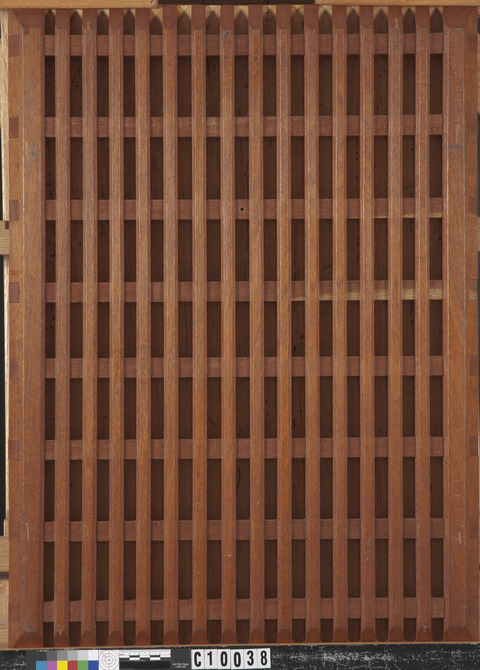
The auxiliary support is an elaborate twentieth-century poplar cradle with sixteen vertical fixed members and eight horizontal movable members (tech. fig. 4). The two outer fixed cradle members are wider at 3.5 cm each, while the interior vertical members are 1.3 cm. The horizontal members are 1.9 cm wide.
Attachment to Auxiliary Support:
The panel was thinned before the cradle was added. The sixteen fixed vertical members of the cradle are glued to the back of the thinned panel.
Condition of Support
The panel is currently in stable condition and remains in plane. Previous insect damage, in the form of woodworm channeling, is visible when viewed from the back. The panel has also been thinned. There are a few splits in the panel that have been conserved (tech. fig. 5). These were likely the result of a previous convexity or movement of the panel. The cradle members are not seized, indicating that the panel has been kept in a stable environment with little change in humidity and temperature since the cradle’s addition. The tangentially sawn panel may have been susceptible to warping, prompting the addition of the cradle. There is slight wear along all edges. The bottom-left corner is dented with some loss of the support.
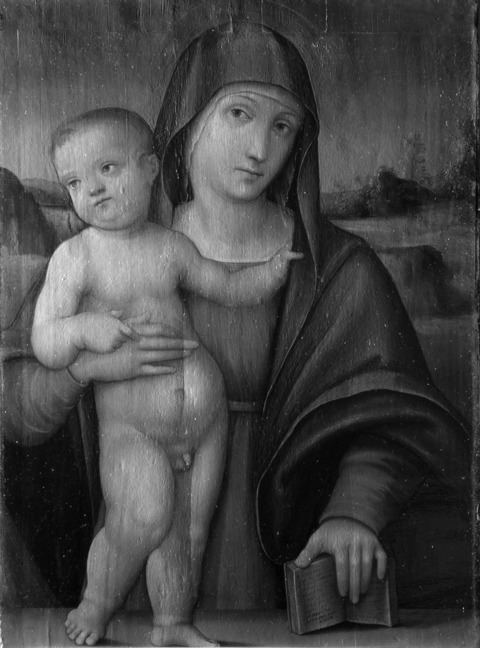
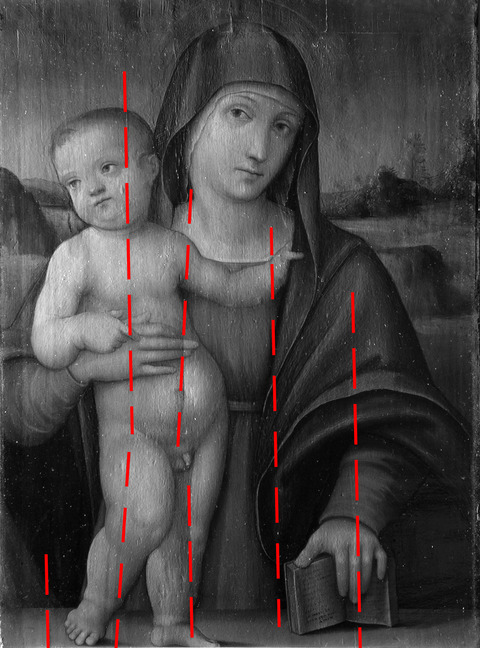
Description of Ground
Analyzed Observed
Materials/Binding Medium:
A cross section from the areas of the sky (tech. fig. 6) was analyzed using SEM-EDS, and the ground layer was identified as calcium sulfate (tech. figs. 7, 8).
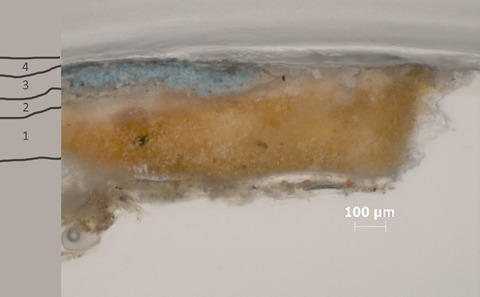
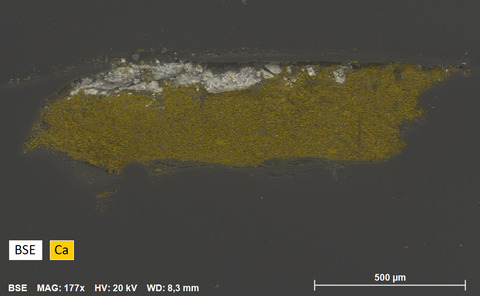
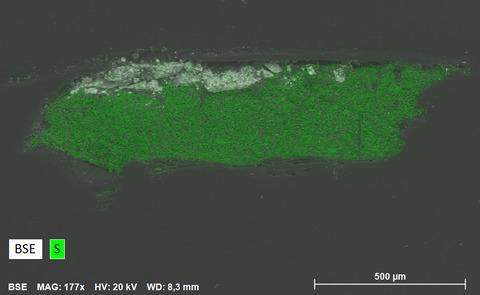
Color:
The ground is off-white in color. It appears to have yellowed slightly over time. The imprimatura is a cool gray color (tech. figs. 6, 9).
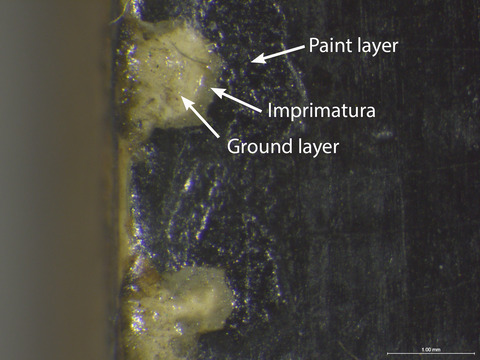
Application:
There is a brushy texture to the painting that is likely due to the application of a streaky imprimatura. Sweeping strokes in different directions are visible on the panel when imaged with raking light. These are also visible in the infrared reflectogram (tech. fig. 10).
Thickness:
Appears to be a single layer of medium thickness gesso
Sizing:
While not visible, animal-glue size would have been applied to the panel prior to the ground layer.
Character and Appearance (does texture of support remain detectable / prominent?):
The wood grain is visible through the ground and paint layers. In the added upper portion of the painting, the ground appears thicker and was deliberately incised in an attempt to mimic the texture of the original panel. Most of the joins in the addition are also visible.
Condition of Ground
Where visible, the ground appears to be in stable condition and well adhered to the panel. No delamination is visible. There are some small losses of the paint and part of the ground along the edges. The ground exhibits a natural cracking pattern related to the wood grain, typical of an aged fifteenth-century panel painting. The cracking network extends through the paint layers and has been accentuated by the accumulation of dirt.
Description of Composition Planning
Methods of Analysis:
Surface observation (unaided or with magnification)
Infrared reflectography (IRR)
X-radiography7
Analysis Parameters:
| X-radiography equipment | GE Inspection Technologies Type: ERESCO 200MFR 3.1, Tube S/N: MIR 201E 58-2812, EN 12543: 1.0mm, Filter: 0.8mm Be + 2mm Al |
|---|---|
| KV: | 20 |
| mA: | 3 |
| Exposure time (s) | 150 |
| Distance from X-ray tube: | 36″ |
| IRR equipment and wavelength | Opus Instruments Osiris A1 infrared camera with InGaAs array detector operating at a wavelength of 0.9-1.7µm. |
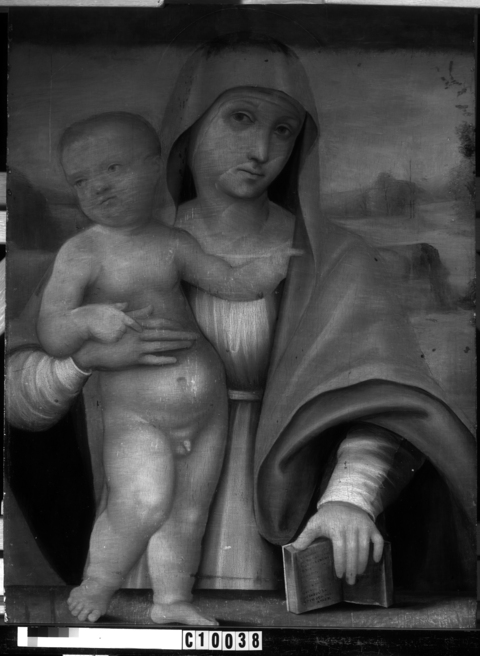
Medium/Technique:
Unknown
Pentimenti:
Slight adjustments to the figures are visible when the painting is examined using infrared reflectography (tech. fig. 10). Both figures show outlining in a fluid medium with loose delicate brushstrokes.8 The head of Christ has been reworked slightly to further refine the shape after the initial outlines (tech. fig. 11). No major changes are present in the reflected infrared image compared to the final composition. The blue paint, present in the extended portion at the upper edge of the panel, appears dark in the infrared reflectogram (tech. fig. 10). This is likely due to the different pigments used in the overpaint and the lack of a ground layer, causing the IR radiation to be absorbed or scattered, rather than reflected back to the camera (see Description of Paint).
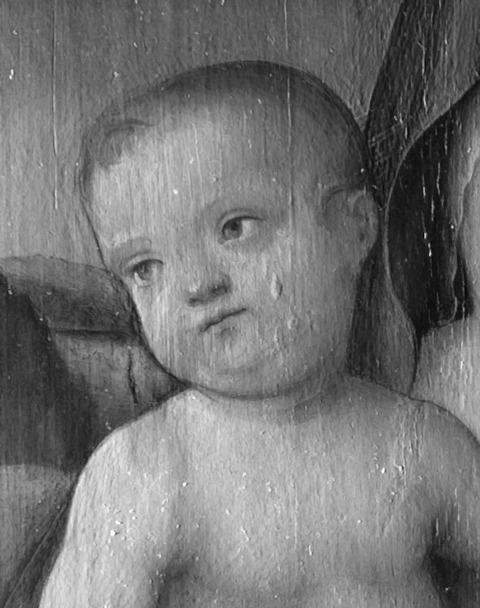
Description of Paint
Analyzed Observed
Application and Technique:
The paint layer has been applied with delicate, confident strokes of paint in the faces of the figures, with subtle tonal changes in the garments. The overall tone of the painting is cool, likely the result of the underlying gray imprimatura. The sky and background paint can be seen extending under the drapery and skin of the figures, suggesting the background and sky were blocked in around their sketched outlines. The figures were then systematically painted, closely following the planned drawing. There is minimal overlap of the distinct areas of color, demonstrating that the artist, or workshop, had carefully determined where each area of paint was to be applied before the painting stage began. Shadows and highlights in the skin were mixed and applied directly using confident brushstrokes to model the forms. Umber outlining is visible along the edges of the child’s body and to delineate the hands and features of the Madonna. Glazed shadows were applied in the red dress and green lining of the robe. In the blue robe, pure azurite, perhaps with a small amount of black, appears to have been used for the darkest darks of the blue robe, while lead white was added to create midtones and highlights in the blue drapery. The blue mountains and detailing in the background, such as in the trees, were applied after the figures were completed. These can be seen extending over the edge of Christ’s face and the Madonna’s veil.
Painting Tools:
Brushes of varying sizes; no evidence of palette knife or other hard-edged tools.
Binding Media:
The binding media is presumed to be drying oil (untested) based on the technique and age of the painting.
Color Palette:
The color palette is simple, comprising specific zones of rich color in red, green, and blue. Skin tones are used for the figures. The colors appear pure, although black and white have been added to create form in the drapery.
XRF analysis suggests a rich, albeit relatively limited, palette was used (tech. fig. 14). The pigments suggested by XRF analysis of the original panel include lead white, copper-containing blue pigment (azurite), copper-containing green pigment, vermilion, iron oxide (earth pigments likely including yellow ocher and umber pigments). It is likely that a glaze composed of red lake pigments was also used in the shadows of the cloak, but this could not be confirmed using XRF. These pigments are consistent with the palette of fifteenth- and sixteenth-century Italian artists.
XRF analysis identified gold on the section of the halo that extends over the panel addition (tech. fig. 12), suggesting the use of gold pigment retouching in this area (table 1, sample 13). No gold was identified on the original portions of the panel, including on the halo on the Christ child, halo of the Madonna (tech. fig. 13), or yellow edge of the Madonna’s robe (table 1, sample 12, 13, 17). It is possible that shell gold was originally present in these areas but was abraded during a previous varnish removal. However, point analysis using XRF detected no trace of gold. Areas of retouching on the halo do appear to have been painted with gold restoration paint (tech. fig. 12). XRF analysis did not detect tin in bright yellow passages, or in the bright yellow leaves of the trees (table 1, sample 16), suggesting it is a yellow ocher pigment.
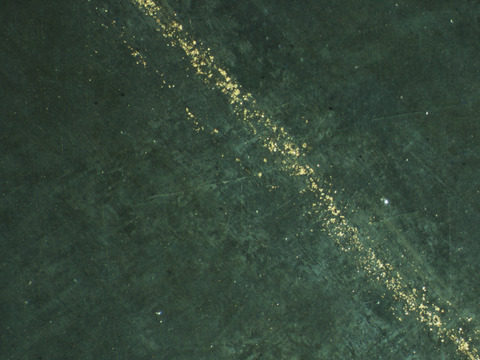
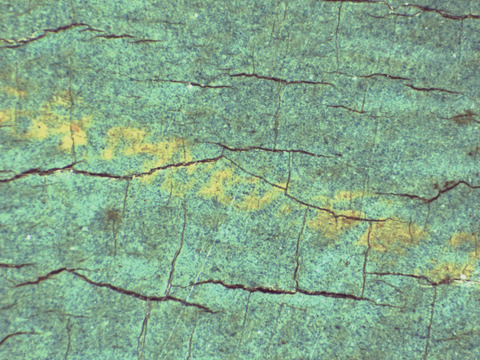
Two samples taken from the areas of sky (sample 1 from an area of restoration and sample 2 from an area of original paint) illustrate the different pigment combinations and layer structures.
Sample 1, taken from the addition at the top of the panel (tech. fig. 14, sample 1), exhibits a single layer of blue paint with no underlying ground layer. Raman microspectroscopy of sample 1 identified ultramarine as the blue pigment. Examination of a dispersed pigment sample did not find the blue particles to be consistent in shape with those of natural lapis lazuli, suggesting the likely use of synthetic ultramarine. Additionally, XRF analysis detected chrome and zinc in several locations on the addition (table 1, samples 1, 14, 11), suggesting the use of chrome yellow and zinc white in the addition. This information, taken together, suggests the addition dates to the nineteenth century or later.
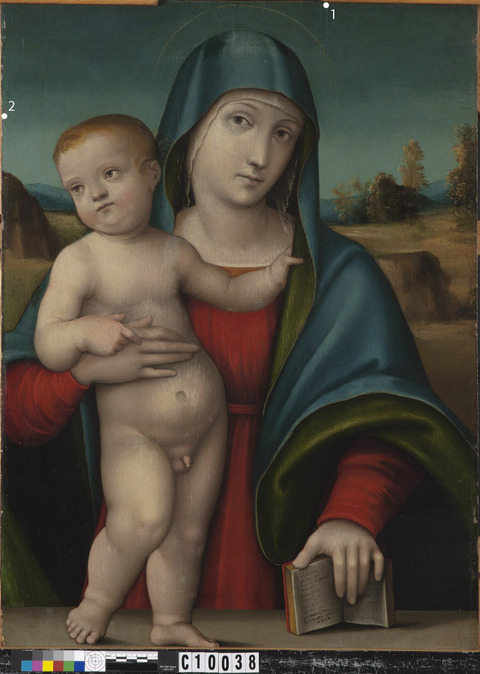
Sample 2, taken from the original panel, was analyzed using SEM-EDS. Copper (tech. fig. 16) and lead (tech. fig. 17) were detected in the blue layer (tech. fig. 15, layer 3) suggesting a mixture of azurite and lead white was applied in this area over a lead white imprimatura (see Description of Ground).

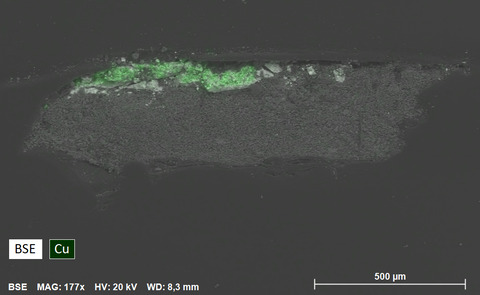
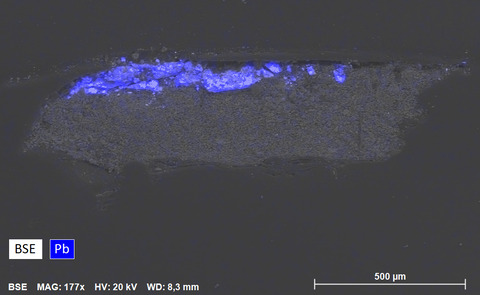
XRF Analysis:
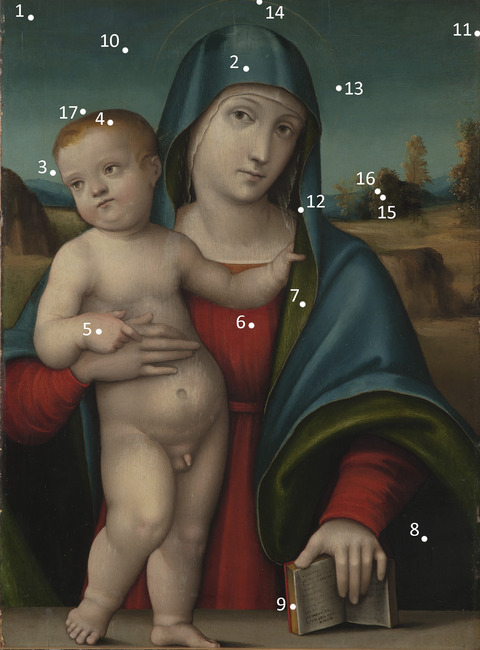
| Sample | Location | Elements | Possible Pigments |
|---|---|---|---|
| 1 | Upper blue edge (added upper edge) | Major: Zn, Pb Minor: Cr, Fe, Co Trace: Ti, Cu, Sn | Zinc white, ultramarine (confirmed with Raman microspectroscopy), cobalt blue (or cobalt dryer), lead white and/or lead-tin yellow, chrome yellow, iron oxide (earth pigments), trace of copper-containing blue pigment (likely azurite), titanium white. |
| 2 | Madonna’s head, robe blue | Major: Cu, Pb Minor: Ca, Zn Trace: As, Fe | Lead white, copper-containing blue pigment (likely azurite), calcium from ground layer (calcium sulfate), zinc white (from retouching), iron oxide (earth pigments), and arsenic (possible from traces of orpiment or realgar). |
| 3 | Blue background near Christ’s head | Major: Cu, Pb Minor: Ca Trace: Fe, Zn | Azurite, lead white, calcium from ground layer (likely calcium sulfate), iron oxide (earth pigments), trace of zinc white. |
| 4 | Christ’s hair, yellow | Major: Pb Minor: Ca, Fe Trace: Cu, Hg | Lead white, calcium from ground layer (likely calcium sulfate), iron oxide (earth pigments), trace of copper-containing blue pigment (likely azurite), trace of vermilion. |
| 5 | Skin tone, Christ’s hand | Major: Pb Minor: Ca Trace: Hg | Lead white, calcium from ground layer (likely calcium sulfate), trace of vermilion. |
| 6 | Red robe, Madonna’s chest | Major: Pb, Hg Minor: Ca, K, Fe, Cu Trace: Mn | Lead white, vermilion, calcium from the ground layer and possibly as a mordant for a red lake pigment, iron oxide (earth pigments including umber), copper-containing blue pigment (likely azurite). |
| 7 | Green part of Madonna’s robe | Major: Pb, Cu Minor: Ca, Fe Trace: K | Lead white, copper-containing blue and/or green pigment, iron oxide (earth pigments), calcium from ground layer (likely calcium sulfate). |
| 8 | Dark area near Madonna’s hand | Major: Pb, Cu Minor: Ca Trace: K, Fe | Lead white, copper-containing blue and/or green pigment, calcium from the ground layer (likely calcium sulfate). |
| 9 | Yellow area of book | Major: Pb Minor: Fe, Ca, Cu Trace: K, Hg | Lead white, iron oxide (earth pigments), calcium from ground layer (likely calcium sulfate), copper-containing blue and/or green pigment, trace of vermilion. |
| 10 | Original blue sky | Major: Pb, Cu Minor: Trace: Fe, Ca | Azurite, lead white, trace of calcium from ground layer (likely calcium sulfate), trace of iron oxide (earth pigments). |
| 11 | Fill on addition | Major: Zn, Pb Minor: Cr, Fe, Co, Cu Trace: Ca, K | Zinc white, lead white, ultramarine (confirmed with Raman microspectroscopy), cobalt blue, chrome yellow, iron oxide (earth pigments), copper-containing blue pigment (likely azurite), calcium. |
| 12 | Yellow edge of robe | Major: Pb, Cu Minor: Fe, Ca Trace: Mn | Azurite (from robe), lead white, iron oxide (earth pigments including umber), trace of calcium from ground layer (likely calcium sulfate). |
| 13 | Halo original | Major: Cu, Pb Minor: Fe Trace: Ca | Azurite, lead white, iron oxide (earth pigments likely yellow ocher), calcium from ground layer (likely calcium sulfate). |
| 14 | Halo addition | Major: Zn, Au, Minor: Cr, Co, Fe Trace: Ca, K, Cu | Gold pigment, zinc white, lead white, ultramarine (confirmed with Raman microspectroscopy), cobalt blue (or cobalt dryer), chrome yellow, iron oxide (earth pigments), copper-containing blue pigment (likely azurite), calcium from ground layer (likely calcium sulfate). |
| 15 | Tree background | Major: Cu, Pb Minor: Fe, Ca Trace: Mn | Lead white, copper-containing green and or blue pigment, iron oxide (earth pigments including umber), calcium from ground layer (likely calcium sulfate). |
| 16 | Yellow leaf on tree background | Major: Cu, Pb Minor: Fe, Ca Trace: Mn | Lead white, copper-containing green and/or blue pigment, iron oxide (earth pigments, likely including yellow ocher and umber), calcium from ground layer (likely calcium sulfate). |
| 17 | Halo on Christ child | Major: Cu, Pb Minor: Fe, Ca Trace: Mn | Azurite, lead white, iron oxide (earth pigments likely yellow ocher), calcium from ground layer (likely calcium sulfate). |
Table 1: Results of X-ray fluorescence analysis conducted with a Bruker Artax microfocus XRF with rhodium tube, silicon-drift detector, and polycapillary focusing lens (~100μm spot).
*Major, minor, trace quantities are based on XRF signal strength not quantitative analysis
Surface Appearance:
The paint appears to be relatively thin, with no areas of impasto. There are significant areas of retouching visible that have clearly discolored, leaving an uneven and damaged look to the painting. The paint appears slightly yellow due to discolored varnish over the surface.
Condition of Paint
A micro cracking pattern typical of paintings on panel extends over the entire painting and is likely a result of natural aging (tech. fig. 19). Small paint losses are scattered throughout. Some wear is visible around the perimeter where the paint is in contact with the frame. Some of the paint has been heavily abraded from a previous cleaning (tech. fig. 20). This is particularly noticeable in the glazes of the trees and shrubbery as well as the halos.
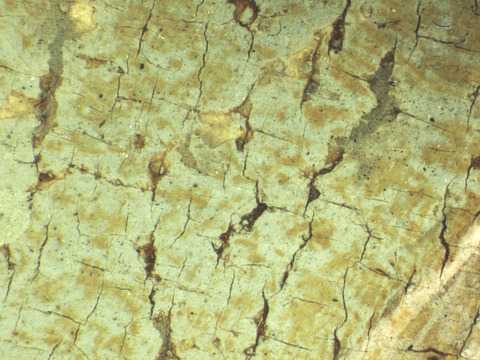
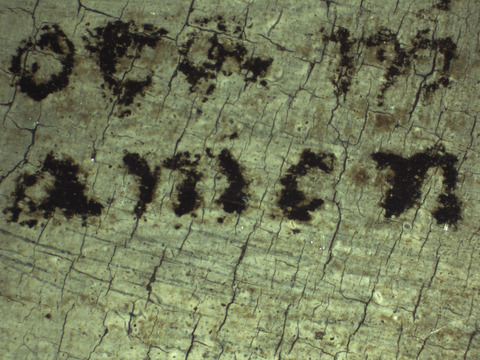
Description of Varnish/Surface Coating
Analyzed Observed Documented
| Type of Varnish | Application |
|---|---|
| Natural resin | Spray applied |
| Synthetic resin/other | Brush applied |
| Multiple Layers observed | Undetermined |
| No coating detected |
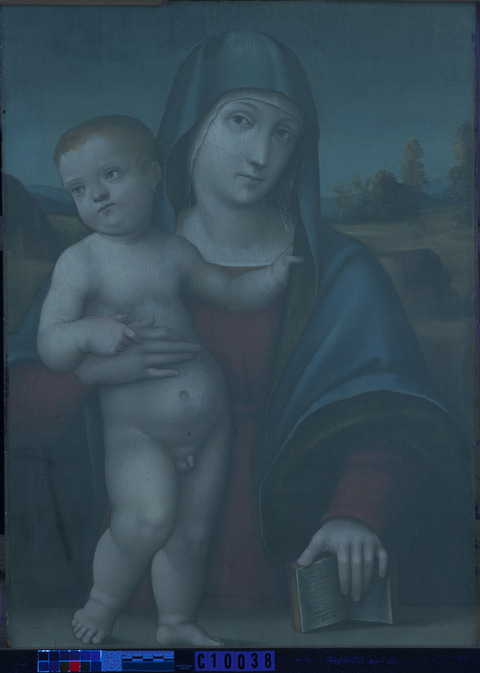
Imaging of the painting with ultraviolet-induced visible fluorescence reveals a fluorescing green layer over the entire surface of the painting that is characteristic of an aged natural resin varnish (tech. fig. 21). In visible light, the painting appears to be slightly yellowed. There are several campaigns of retouching from previous restoration campaigns.
Condition of Varnish/Surface Coating
The discolored varnish imparts a yellow hue to the painting. However, the overall tone of the paint layer is cool, and while the colors would certainly look brighter with varnish removal, the overall tone will continue to have a bluish-green hue due to the cool imprimatura. A few small scuffs and minor losses are visible, particularly around the perimeter where the painting is in contact with the frame, but otherwise the varnish is intact. Retouching is present throughout the painting, some of which has severely discolored and detracts from the forms in the figures. The most recent retouching fluoresces under ultraviolet-induced visible fluorescence. Older campaigns of retouching (tech. fig. 22), for example in the face, do not fluoresce. There is some minor scratching in the varnish layer, likely from handling or framing, but this has not impacted the paint layer. Surface dirt is present in small amounts throughout the painting.
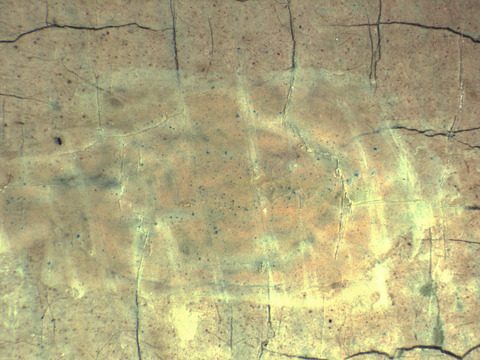
Description of Frame
Original/first frame
Period frame
Authenticity cannot be determined at this time/ further art historical research necessary
Reproduction frame (fabricated in the style of)
Replica frame (copy of an existing period frame)
Modern frame
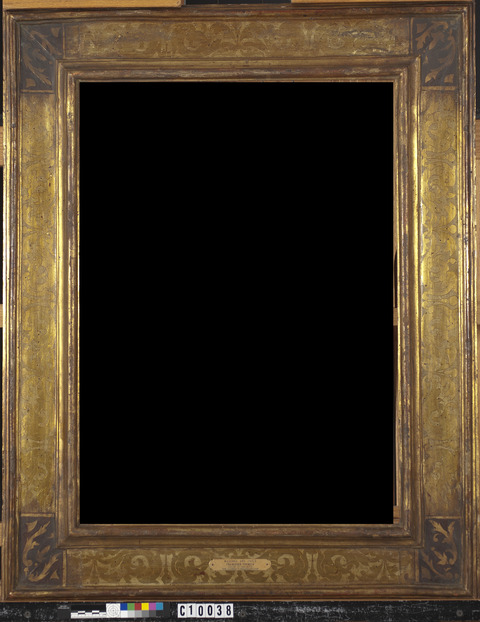
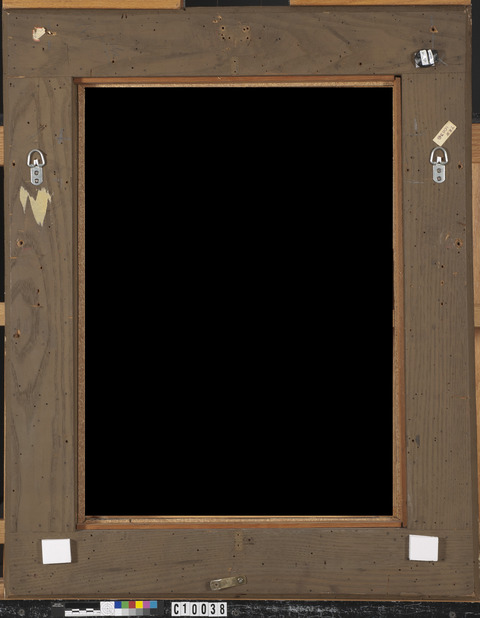
Frame Dimensions:
Outside frame dimensions: 86 × 68 × 4.5 cm
Sight size: 65 × 45 cm
Distinguishing Marks:
None
Description of Molding/Profile:
As per observations completed by historian and frame specialist Timothy Newbery at the IMA on 19 January 2012, the frame originates from Florence in about 1910 (tech. fig. 23).9 Newbery suggests that it was made for Duveen, probably in a Florence workshop, and is based on a sixteenth-century Tuscan pattern (see profile, tech. fig. 25). The frame is constructed from poplar and is half-lapped (tech. fig. 24). A red-orange bole layer shows through the gilding. The frieze has decorative elements including dragon heads and acanthus leaves. These are incised and gilt with a white background. The corners are brown and appear gold (or bronze). The right sight size was adjusted 4 inches higher and 1 inch wider. The decorations on the corners were added after this adjustment.
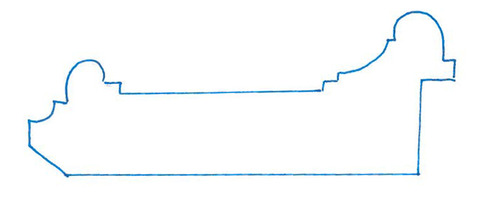
Condition of Frame
The frame was damaged in the past and restored. It is in poor condition, particularly at the corners where restoration is visible in ultraviolet-induced visible fluorescence (tech. fig. 26).
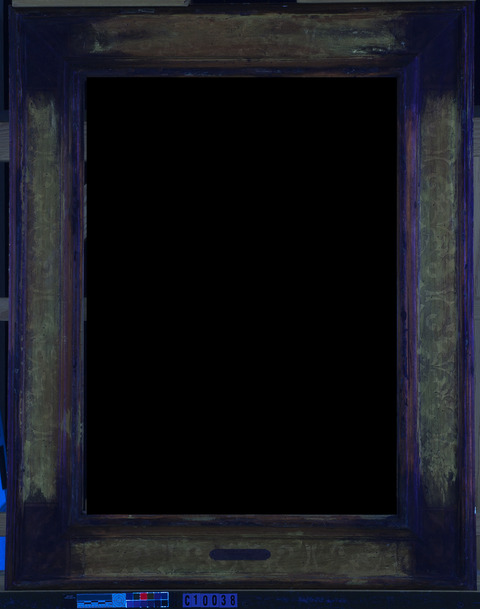
Additional Notes or Comments
Newbery recommends that the corners be symmetrically reworked to match the white and gold incisions.
Notes
-
Paul A.J. Spheeris, “Conservation Report on the Condition of the Clowes Collection,” 25 October 1971, Conservation Department Files, Indianapolis Museum of Art at Newfields. ↩︎
-
Martin Radecki, Clowes Collection condition assessment, undated (after October 1971), Conservation Department Files, Indianapolis Museum of Art at Newfields. ↩︎
-
Intermuseum Conservation Association, “Clowes Collection Conservation Report,” C10038 (2017.90), 8–10 April 1974, Conservation Department Files, Indianapolis Museum of Art at Newfields. ↩︎
-
Memorandum from Martin Radecki to Bret Waller, “Conservation Work on Clowes Fund Collection,” 16 February 1996, Conservation Department Files, Indianapolis Museum of Art at Newfields. ↩︎
-
Peter Klein, wood identification report, C10005 (2020.1), 1999, Conservation Department Files, Indianapolis Museum of Art at Newfields. ↩︎
-
Elvacite 2040 (synthetic resin) was used to fill the cradle so that its appearance would be minimized in the X-radiograph, allowing the composition to be better interpreted. ↩︎
-
Elvacite 2040 (synthetic resin) was used to fill the cradle so that its appearance would be minimized in the X-radiograph, allowing the composition to be better interpreted. ↩︎
-
Giorgia Mancini and Nicholas Penny, The Sixteenth Century Italian Paintings, vol. 3: Bologna and Ferrara (London: National Gallery Company Ltd, 2016), 154. ↩︎
-
Timothy Newbery, condition report on frame for C10015 (2017.90), 19 January 2012, Conservation Department Files, Indianapolis Museum of Art at Newfields. ↩︎
Additional Images
